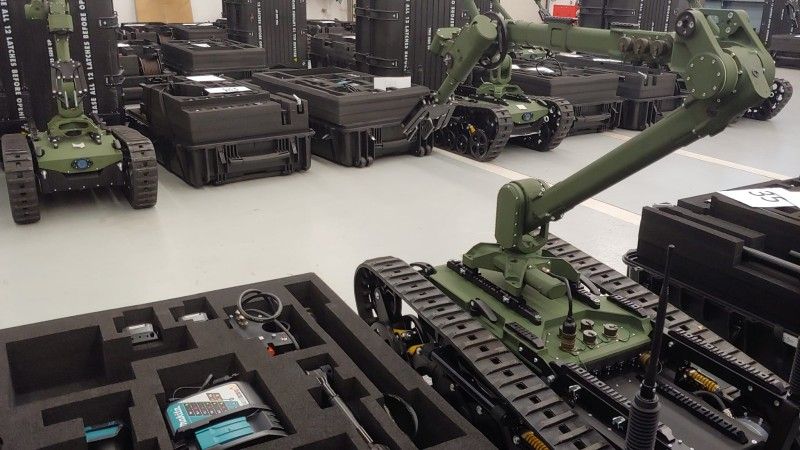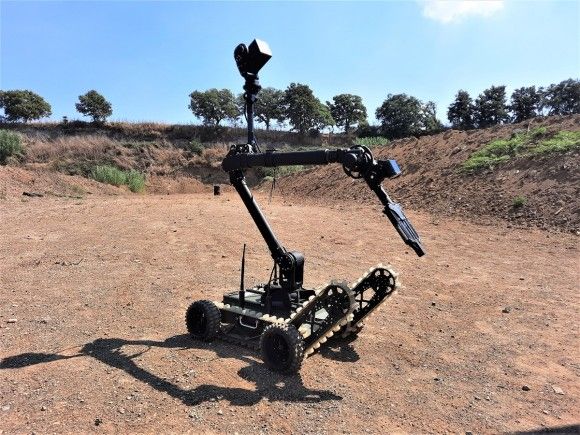Industry
Łukasiewicz - PIAP Summarizes the Year 2021

Photo. Łukasiewicz-PIAP
Łukasiewicz – PIAP can consider the passing year to be a major success. During the year 2021, several deliveries for the Polish and foreign security and uniformed services took place.
Industrial Research Institute for Automation and Measurements, among the most important orders, includes the delivery of five heavy PIAP IBIS EOD robots, received by the Police. Delivery of the second lot of the RPP Patrol-Portable Robots (“Robot Inżynieryjny 1806” model) for the Polish military also had a key relevance for the Institute.
Let us recall that delivery of 35 RPP robots in total was completed based on an agreement signed by and between the Armament Inspectorate of the Polish Ministry of Defence, and the Łukasiewicz-PIAP institute. The systems have been handed off together with a spare parts kit (ZCzZ) and a maintenance and repairs kit (ZON).
RPP is a robot with a mobile base that weighs 75 kilograms. The acquired robots are to be used by the engineering units, for detecting, removing, picking up or neutralizing mines, unexploded ordnance and IEDs, within the scope of combat and peacekeeping operations abroad.
Works on more orders were also carried out for the foreign entities. The Institute also delivered its robotic systems to customers in Israel, Indonesia, and Italy. The Armed Forces of the aforesaid states received the PIAP TRM and PIAP GRYF platforms.
Mobile robots developed at Łukasiewicz Research Network - Industrial Research Institute for Automation and Measurements (PIAP) have been procured by customers from 22 countries so far. Despite the unquestionable success above, the management is still taking steps towards the expansion of the PIAP's foreign market footprint.

Photo. Łukasiewicz-PIAP
The new generation of the PIAP Gryf robot enjoys the most significant interest. It is the best known, and most proven of the medium-sized PIAP robots, that is already being operated by armed forces around the world, in South Korea, Indonesia, Nigeria, Senegal, and Romania. The PIAP Gryf bomb disposal robot is tailored to carry out hazardous materials neutralization tasks, explosive ordnance disposal included. It weighs 48 kilograms.
The hybrid drive system makes it possible for the robot to move efficiently on any surface, in rough terrain, and in buildings (moving up and down the staircases). The robot’s wheels can be removed which further reduces its size, and thereby makes it possible to carry out operations in narrow spaces - inside an airliner for instance.
The robot has been equipped with IR cameras for day/night use, a Hi-res camera with a 33x optical zoom, and a gripper camera that makes it far easier to pick up hazardous materials. The robot is controlled via a modern, light control panel that, thanks to a brand new design, allows for intuitive joystick operation in all degrees of freedom of the manipulator's arm. The robot's movement can also be quite fluid. The large touchscreen makes it possible to inspect suspicious cargo, luggage, or IEDs, at a safe distance.

PIAP Ibis robots procured by the Polish Police this year are designed to be operated in bomb-threat conditions, allowing the user to pick up, transport and remotely neutralize luggage, IEDs, and packaging materials, should a suspected threat emerge. PIAP IBIS may be operated inside airliners, airport terminals, luggage sorting areas, within car parks and runways, namely in the airport areas where a need to verify and neutralize potentially dangerous packaging may emerge.
Large mobile robots may also be fitted with extra equipment such as disrupters, X-Ray scanners, ABC sensors or explosives detectors. Their long operational range is one of the main advantages, keeping the operator safe and allowing him to work in comfort.
Since 2011, the PIAP IBIS has also been used by the Polish airports, with Warsaw Chopin Airport being the first one to use the PIAP’s system.
The smallest of the robots sold this year is the PIAP TRM. TRM consists of a pipe-based framework, featuring a camera, microphone, and visible or infra-red light illumination devices. The device is driven by two flexible rubber wheels mounted on the sides of the robot. The robot has been designed to be able to withstand falls from significant heights (up to 9 meters, on hard surfaces), thus it may be thrown into a building, or into the operational area within an open space, from a long distance (15-20 meters). Then, via remote control, it may carry out a relevant reconnaissance task.
The TRM robot can also carry flashbang grenades. It could be used then to introduce chaos among and disorganize the potential adversary. The motors used in the robot are completely silent. The device makes it possible to smoothly regulate the angle of view of the camera, within the full 360-degree range, without any need for using tools. It is also possible to apply a variety of LED illumination devices. The advantages also include low weight (1.5 kilograms for the base version) and external size of the control panel, or the ability to operate several robots, using a single control panel.